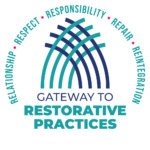
Myth: The louder we speak, the greater chance of controlling behavior
Yelling produces yelling. The louder an adult gets, the louder children get. Negative examples of confident tone of voice: screaming, swearing, name calling, shouting, or sarcasm.
Incorrect Response:
Educator: Says in a loud voice to a group of students across the hallway, “Line up. Line up for lunch.”
Students: Talk louder and pretend to laugh at a joke.
Educator: Raises voice louder, “I told you to get in a straight line for lunch.”
Students: Laugh and talk louder.
Fact: Softer and Closer
Talk to children about inappropriate behavior in private, rather than in front of others. Show respect. Talk with them, rather than “at’ them. Move-in close (about an arm’s distance), get at student’s level, look student in the eyes, and speak in a soft tone, if not a whisper, directly and slowly. The calm voice helps avoid escalating a power struggle. “The calm voice is comforting and powerful, especially for the student experiencing a difficulty and needing supportive guidance.”1
Voice Match
If a student can’t voice match, whisper, “I can hear you. I’m right here.” They will automatically lower their voice for a while. You want to be in closer proximity to the student and use a softer, quieter voice. This is the opposite of our natural reaction to get louder.
Correct Response:
Educator: Walk over to students who are in “line” for the cafeteria; get about an arm’s length away from students. Say in a calm voice, “When you’re in a straight line, we can go in the cafeteria for lunch.”
Students: Comply with Educator’s instructions.
How do you use your voice for effective discipline?
Sources:
- Carosso, Dr. John, The Softer and Closer Approach, October 28, 2010, http://www.helpforyourchild.com/the-softer-and-closer-approach/
- Image: megaphone [commons.wikimedia.org]

